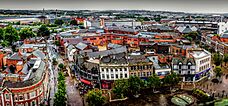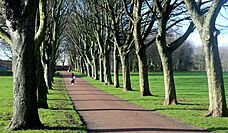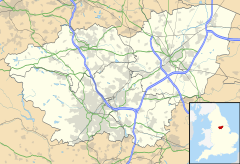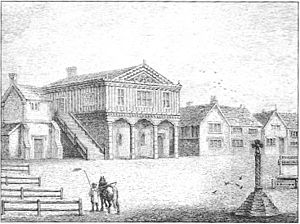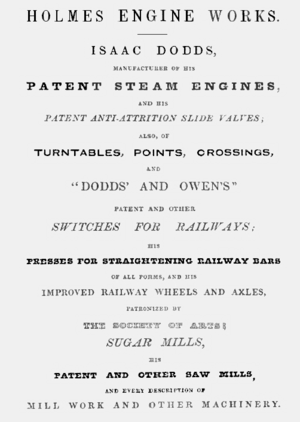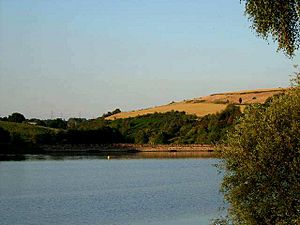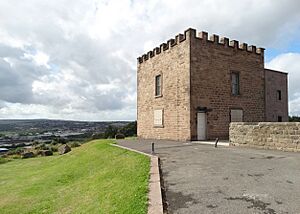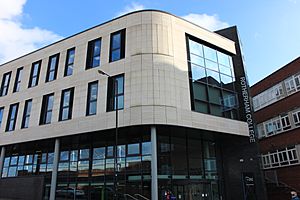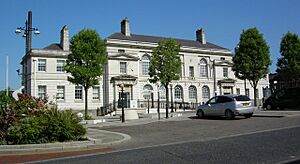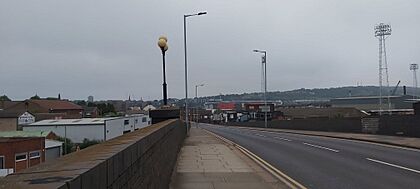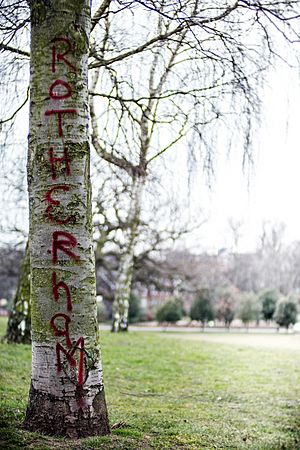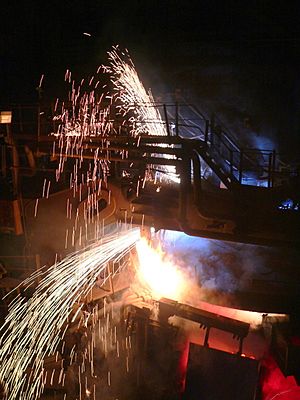Rotherham facts for kids
Quick facts for kids Rotherham |
|
|---|---|
| Market town | |
|
|
|
| Population | 109,691 (2011 census) |
| OS grid reference | SK4392 |
| Metropolitan borough |
|
| Metropolitan county | |
| Region | |
| Country | England |
| Sovereign state | United Kingdom |
| Post town | ROTHERHAM |
| Postcode district | S60-S62, S65, S66 |
| Dialling code | 01709 (01226 in areas) (01909 in areas) (0114 in areas) |
| Police | South Yorkshire |
| Fire | South Yorkshire |
| Ambulance | Yorkshire |
| EU Parliament | Yorkshire and the Humber |
| UK Parliament |
|
| Website | https://www.rotherham.gov.uk/ |
Rotherham is a market town in South Yorkshire, England. It is located where the River Rother meets the River Don. The town gets its name from the River Rother. Rotherham is the largest town in the Metropolitan Borough of Rotherham.
For a long time, Rotherham was known for farming, making glass, and milling flour. Later, in the 1700s and 1800s, it became famous for its coal mining and steel industries. Rotherham is part of the historic county of Yorkshire. In 1974, it became one of the four main areas in South Yorkshire.
In 2011, Rotherham had a population of 109,691 people. By 2021, the town's population had grown to 129,897.
Contents
History of Rotherham
Early Settlements
People have lived in the Rotherham area since the Iron Age and Roman times. A small Roman fort was found near the River Don at Templeborough.
Rotherham was founded in the early Middle Ages. Its name means "homestead on the Rother." The River Rother's name comes from old words meaning "main river." An Anglo-Saxon village was built near where the Romans crossed the River Don.
The Domesday Book of 1086 mentions Rotherham as a manor. It describes a church, meadows, woodlands, and a mill. Later, monks from Rufford Abbey gained rights to hold markets and fairs in the town.
In the 1480s, Thomas Rotherham, who was the Archbishop of York and born in Rotherham, started building a college called the College of Jesus. It was one of the first brick buildings in the area. The college taught subjects like theology, music, and writing. This made Rotherham a modern and important town. However, the college was closed in 1547. Today, very little of the original building remains. Thomas Rotherham College is named after him.
Mary, Queen of Scots stayed in Rotherham for two nights in January 1569.
Industrial Growth
Rotherham has been a place for making iron since Roman times. In the late 1700s, coal was found nearby, making Rotherham important during the Industrial Revolution. Coal was sent out by river, which led to improvements in the River Don to make it easier for boats to travel.
During the Industrial Revolution, iron and then steel became the main industries in Rotherham. The Walker family built a large iron business in the 1700s. They made high-quality cannons, including many for the famous ship HMS Victory. They also made cast iron bridges.
More ironworks opened in the 1800s, like Effingham Ironworks. Other companies made brass products that were sent all over the world. The Parkgate Ironworks, started in 1823, made wrought iron plates for Isambard Kingdom Brunel's huge steamship, the SS Great Eastern. The Steel, Peech and Tozer steelworks at Templeborough was once over a mile long and employed 10,000 workers. It closed in 1993 and is now the Magna Science Adventure Centre.
The first railway stations in Rotherham opened in 1838. These helped transport goods and people.
Joseph Foljambe created the Rotherham plough, which was the first successful iron plough sold widely.
A glass works started in Rotherham in 1751. This company, Beatson Clark & Co, became one of the town's biggest manufacturers, making glass medicine bottles for export. It still makes glass containers today. Other successful industries in the 1800s included pottery and making brass items.
Rotherham is also home to the Advanced Manufacturing Park (AMP). This park has world-class companies like Rolls-Royce and McLaren Automotive.
Milling grain into flour was another traditional industry. The Rank Hovis mill in Canklow Road operated until 2008.
Enterprise Zone
In 1983, Rotherham became an "enterprise zone." This meant new businesses received benefits to encourage them to set up in the area. This helped bring new industries and development to the town.
Floods of 2007
Rotherham experienced serious flooding in the summer of 2007. Roads, schools, and transport services were closed. Homes and businesses, including the Parkgate Shopping complex, were damaged. There was a big worry about Ulley Reservoir because its dam showed signs of damage. Thousands of homes were evacuated. Emergency services worked to lower the water level and save the dam, which held.
To prevent future floods, a new wetland and flood storage area called Centenary Riverside park was built. It is now a local nature reserve and home to a large sculpture called Steel Henge, which looks like Stonehenge but is made from iron.
Child Safety Concerns
In 2014, a report by Professor Alexis Jay looked into how child safety issues were handled in Rotherham between 1997 and 2013. The report showed that many children had been harmed. Following this, Louise Casey also investigated Rotherham Council. Her report in 2015 said the council was not doing enough to protect children.
Because of these reports, the government appointed special commissioners to help run the council. The council leader and cabinet resigned to allow for a "fresh start." Jayne Senior, a former youth worker who had tried to expose these issues for years, was later honored for her efforts.
Landmarks

All Saints Minster is the town's oldest and most famous landmark. It is a beautiful church built with a special red sandstone. A bell tower was added in 1501, and today the Minster has 13 bells. Parts of the church date back to Saxon and Norman times, but most of it was built in the 1400s. Experts have called it one of the best churches of its style in the country.
Near the town centre is the 15th-century Chapel of Our Lady of Rotherham Bridge. It is one of only four bridge chapels still existing in England. The chapel was once used as a town jail and a shop before being restored in 1923.
Boston Castle, in Boston Park, was built as a hunting lodge between 1773 and 1774. It was named after Boston, Massachusetts, to show support for the Americans in their war for independence.
Clifton Park Museum is located in Clifton House, an 18th-century building in Clifton Park.
On the edge of Rotherham is the Catcliffe Glass Cone. This brick-built furnace is the oldest of its kind still standing in Western Europe. It is now a protected monument.
The ruins of Roche Abbey, south of Maltby, are unusual because many of their multi-storey walls are still standing. Most other abbey ruins from that time are only foundations.
Education
Rotherham has three colleges for further education: Thomas Rotherham College, Dearne Valley College, and the Rotherham College of Arts and Technology. The Rotherham College of Arts and Technology has campuses in the town centre and in Dinnington.
Local Government
Rotherham is governed by the Rotherham Metropolitan Borough Council. This council is also part of the South Yorkshire Mayoral Combined Authority, which is led by the Mayor of South Yorkshire.
Rotherham was first governed by local officials in 1801, who were responsible for streets and lighting. In 1871, Rotherham became a municipal borough, and in 1902, it became a county borough. In 1974, the larger Metropolitan Borough of Rotherham was created, combining Rotherham with several nearby towns and rural areas.
The Labour Party has controlled the council since 1974. After the child safety scandal in 2014, the way local councillors are elected changed. In the May 2021 election, Labour kept control, but the Conservative Party gained many seats.
Geography
Rotherham is built on the slopes of two hills. The town centre is in the valley between these hills, near where the River Rother meets the River Don.
Outside the town centre, the Rotherham district is mostly countryside. It includes the beautiful Wentworth Woodhouse estate.
Rotherham is connected to Sheffield by roads and the Trans Pennine Trail. Rotherham Central station has frequent trains to Sheffield, Doncaster, York, and Leeds.
Green Belt Area
Rotherham is surrounded by a "green belt" area. This is land kept open to stop towns from growing into each other and to protect the countryside. The green belt covers about 72% of the Rotherham borough. It includes places like the Wentworth Woodhouse estate, the River Rother, and various parks and golf courses.
Population and Diversity
In 2011, 14.4% of Rotherham's town population was non-white. Rotherham town has a larger percentage of Asian people and a slightly larger percentage of black people compared to the wider borough. Rotherham has a notable Pakistani community.
As of 2021, Rotherham's population was 86.1% White, 9% Asian, 1.7% Mixed, 1.5% Black, 1.2% Other, and 0.5% Arab. The main religions were 49.2% Christian, 40.1% No Religion, and 9.6% Muslim, with smaller Hindu and Sikh communities.
Culture and Fun Things to Do
Museums
The Magna Science Adventure Centre is an exciting place built in an old steelworks. It has interactive exhibits about science and adventure and is a popular tourist spot.
Clifton Park Museum is a museum in Clifton Park with free entry.
Entertainment
The Civic Theatre is in the town centre. The Westgate area is known for Rotherham's nightlife.
The historic Three Cranes Inn, Rotherham's oldest non-religious building (dating back to 1470), reopened in 2019 as a micropub.
A new leisure area on Forge Island, with an 8-screen cinema, restaurants, and a hotel, opened in 2024.
Events
Rotherham hosts several events each year:
- Rotherham Rocks: A fashion show in July.
- Rotherham by the Sea: In August, Clifton Park is turned into a beach with sand and seaside attractions.
- Rotherham Show: An annual event in Clifton Park in September with stalls, shows, and live music.
- Rotherham Real Ale and Music Festival: One of the UK's largest real ale festivals, held at the Magna Centre.
In 2016, Rotherham had its first carnival, with a parade and festival in the park. In 2022, Rotherham hosted games for the UEFA Women's Championship at the New York Stadium.
Since 2025, Rotherham has been the world's first "Children's Capital of Culture."
Parks
Clifton Park is a large park in the town centre. It has sports facilities, a paddling pool, a small fairground, and an adventure park. It hosts big events like the Rotherham Show and an annual fireworks display.
Minster Gardens is an urban park next to Rotherham Minster. It has an amphitheatre for outdoor events.
Music
Rotherham has several Brass band clubs. It is also known for rock bands like Bring Me the Horizon and The Reytons.
Shopping
Rotherham town centre has various shops. Many new independent businesses have opened since 2009. In 2015, Rotherham won an award for its independent town centre shopping.
Local Media
Rotherham has local radio stations like Rotherham Radio and Rother Radio. The Rotherham Advertiser is the town's local newspaper.
Rotherham in Film and TV
| Film name | Locations used | Genre |
|---|---|---|
| The Girl with the Pistol (1968) | Frederick Street Bus Station | Comedy |
| King Ralph (1991) | Dalton | Comedy |
| I.D. (1995) | Centenary Market & Millmoor | Police drama |
| When Saturday Comes (1996) | Outdoor scenes in Rotherham | Football drama |
| Brassed Off (1996) | Rotherham town centre and district | Music-themed drama |
| Five Pillars (2013) | Rotherham Bus Station, Eastwood, Wickersley | Social realist drama |
Chef Jamie Oliver's TV series Jamie's Ministry of Food (2008) was based in Rotherham. He tried to make Rotherham a "culinary capital" by teaching people to cook.
The band Arctic Monkeys mention Rotherham in their song "Fake Tales of San Francisco".
Sports in Rotherham
Football
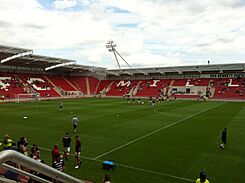
The town's football team, Rotherham United, played in the EFL Championship in the 2022–23 season. They play at the New York Stadium.
Rugby
Rotherham Titans rugby union team reached the Guinness Premiership in 1999 and 2003. The Rotherham Giants play rugby league.
Cricket
Rotherham Town Cricket Club has been around since 1846. They play at Clifton Lane.
Notable Sports People
Many famous sports people are from Rotherham, including hurdler Chris Rawlinson, Olympic gold medallist sailor Paul Goodison, Olympic silver medallist runner Peter Elliott, former England goalkeeper David Seaman, golfer Danny Willett, and World Cup referee Howard Webb.
Freedom of the Borough
This is a special honour given to individuals or military units.
- Julie Kenny: March 2021
- Gavin Walker: January 2022
- The Yorkshire Regiment: In 2009, they were given the right to march through Rotherham with "flags flying, bands playing and bayonets fixed."
Famous People from Rotherham

Rotherham is the hometown of the Chuckle Brothers, and footballer Jess Park. Famous football figures like manager Herbert Chapman and goalkeeper David Seaman are also from the area. World Cup referee Howard Webb and gymnast Ella-Mae Rayner are from Rotherham.
Actors Liz White, Ryan Sampson, Dean Andrews, and Darrell D'Silva are from Rotherham. Former leader of the Conservative Party, William Hague, and Sir Donald Coleman Bailey also hail from here. Presenter James May grew up in Rotherham, and his former co-presenter Jeremy Clarkson trained as a journalist at the Rotherham Advertiser.
Musicians like Christopher Wolstenholme of Muse, Rebecca Taylor, and the band Jive Bunny & The Mastermixers were born or raised in Rotherham.
Twin Towns
Rotherham has an official twin town:
- Saint-Quentin, Aisne, France
Partner Towns
Rotherham also has three partner towns:
- Cluj-Napoca, Romania
- Riesa, Germany
- Zabrze, Poland
See also
 In Spanish: Rotherham para niños
In Spanish: Rotherham para niños
- Listed buildings in Rotherham (Boston Castle Ward)


